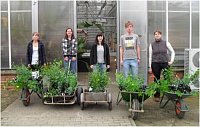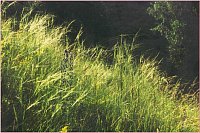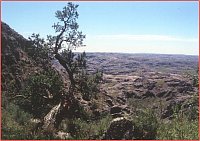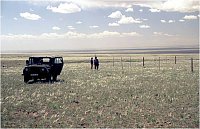Research focus

Our working group is renowned for its basic and applied research across a wide range of plant ecological fields including population ecology, population genetics, biological invasions, conservation biology and vegetation ecology. We apply a number of individual or combined techniques ranging from field studies and garden or greenhouse experiments to molecular assessments. Our study sites include temperate and tropical ecosystems (mainly Germany, Tropical Andes, Subtropical mountain forests, Southern Siberia).
Plant population genetics

We use molecular approaches (AFLP, microsatellites) to study the genetic variation of plant populations. The results are often combined with environmental data (soil, climate) and biological data from e. g. germination and "common garden" experiments. Our research priorities are:
- Conservation Biology: we deal with the genetic diversity of rare and endangered grasslands species (such as various Stipa species, Pulsatilla vulgaris, Adonis vernalis), and often associate the data with reproductive traits.
- Biological invasions: we analyze the genetic structure of populations of alien species and compare it with the situation in the regions of origin.
- Phylogeography: we try to understand historical events such as postglacial migration of steppe plants and that of (sub-)tropical high mountain species.
Regeneration of (sub)tropical forests

In the South American Andes, vast areas of (sub-) tropical forests are nowadays deforested, in which the use of fire is a common tool. Restoration of deforested habitats will recuperate biodiversity and ecosystem service supply. Forest regeneration in burned habitats is slow due to various barriers, in which unfavorable habitat conditions and missing seed sources are the most important. Several of our projects are going to fill gaps in the knowledge of drivers for (sub-) tropical montane forest regeneration, which remain less well studied compared to lowland forest regeneration. Mainly in Bolivia and Argentina, we study various aspects of forest regeneration and of generative recruitment of different mountain tree species (e.g. Clusia spp., Polylepis spp.).
A new DFG project (starting in 2015) is going to analyse the "Combined effects of altitude, fire and biotic interactions on the regeneration of subtropical mountain forest species in Central Argentina".
Summary: Climate change is predicted to indirectly increase the occurrence of extreme disturbances such as wildfires. Global evidence indicates that rising temperatures and more pronounced drought events, together with changes in land-use, will exacerbate both fire frequency and fire intensity in many ecosystems, leading to changes in associated vegetation structure, species composition and ecosystem functioning. Our project addresses the questions of how environmental stress and disturbance affect post-fire regeneration of native mountain tree and scrub species in subtropical Central Argentina across an elevational gradient, and how responses of woody species are mediated by biotic interactions and local adaptation. We take advantage of the occurrence of a high-intensity, crown mega-fire that spread across an elevational gradient of 1600 m in the Córdoba mountains in 2013, and we combine observational and manipulative experimental studies to shed light on the interplay of climate change, livestock impact and plant-plant interactions on the responses of subtropical forest species to post-fire environments. Our integrative approach, which joins an observational study along opposing gradients of temperature and moisture with field experiments to produce a dynamic model, will substantially enhance our understanding of species responses to climate warming and to post-fire disturbances.
Conservation of steppe ecosystems in southern Siberia

The subproject “vegetation and steppe restoration” of the interdisciplinary KULUNDA project ( www.kulunda.eu ; funded by the BMBF) has two major objectives: 1) assessing composition, distribution and carbon sequestration potential of the non-crop vegetation types, and 2) developing and testing guidelines for steppe restoration measures. The existing information on vegetation cover and land use in the Kulunda steppe region will be updated and integrated as part of a vegetation map. We also aim to compile a biological trait database for key steppe plants (essential for restoration trials). Our final aim is to upgrade and improve available restoration techniques for steppe ecosystems as well as, together with the stakeholders, the test and fine-tuning of specific measures for the Kulunda steppe.




![Dictmanus albus [(c) Christian Ristok] Dictmanus albus [(c) Christian Ristok]](/im/1401451667_284_0.jpg)
